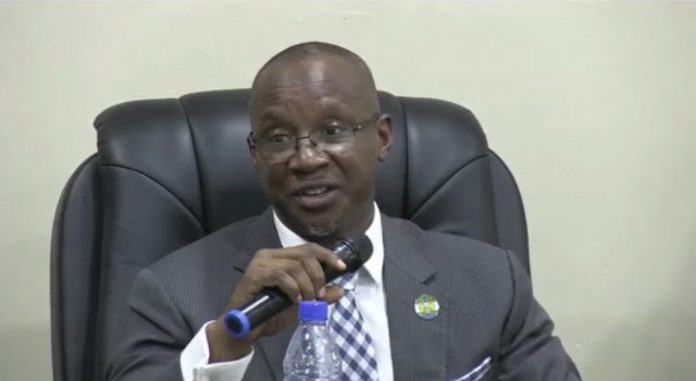By Amin Kef Sesay
In order to get a proper understanding of the current status quo of the Minerals Sector in the country, this medium engaged the Director General of the National Minerals Agency (NMA), which is the regulatory agency of the sector, Julius Daniel Mattai.
The Director General disclosed that as part of his campaign manifesto, Julius Maada Bio, promised that if elected President of Sierra Leone he would change the narrative within the sector by ensuring that there is a thorough transformation of the minerals sector to an extent that proceeds derived from that sector will benefit the vast majority of Sierra Leoneans.
Mattai intimated that translating that promise into a tangible reality on the ground has seen the minerals sector going through a transformative phase and the Ministry of Mines & Mineral Resources (MMMR) and the National Minerals Agency (NMA) are spearheading the transformation drive.
According to him , since 2018 to date the minerals sector has recorded certain achievements so far including the following:
He said with regards Mining Companies, in January 2018 there were six large-scale mining companies (mining rutile, ilminite, bauxite and diamonds) operating in Sierra Leone.
As up to March 2021, he continued, there are now eleven large-scale mining companies (mining gold, diamonds, zircon bauxite, iron-ore and rutile) in Sierra Leone.
The five new large-scale mining companies in operation are MEYA Mining Company, Wongor Investment Mining Company, Sierra Diamonds Mining Company, Kingho Mining Company and Cheng Li Mining Company.
In January 2018, he added, there were seven small-scale mining companies operating in Sierra Leone. In March 2021 there are now thirteen small-scale mining companies operating in Sierra Leone.
In January 2018 there was only one industrial gold mine operating in Sierra Leone. In March 2021 there are nine industrial Gold mines (6 small-scale and 3 large-scale) operating in Sierra Leone.
In January 2018 there were two mineral sand (rutile, zircon, coltan, etc.) mines operating in Sierra Leone. In March 2021 there are six mineral sand mines operating in Sierra Leone.
In terms of Mineral Export and Revenue, Mattai revealed that, according to data from Statistics Sierra Leone (SSL), the minerals export for 2019 was USD 430 million, accounting for about 62% of total exports. In 2020, minerals export was circa USD 313 million, and accounted for 48% of total exports from Sierra Leone.
Total revenue to the Government of Sierra Leone, from mining, was USD 56 Million (2018), USD 61 million (2019) and USD 44 Million (2020), the reduction mainly due to the COVID 19 Pandemic.
With reference to Employment, he pointed out that total number of Sierra Leoneans employed by mining companies in January 2018 was 8,552; and total number of Sierra Leoneans employed by mining companies in March 2021 is 9,683. With Kingho Mining Company, Cheng Li Mining Company, Sierra Diamonds Limited and Supreme Minerals Limited mining companies currently recruiting, this number is expected to increase significantly in the short term, he expressed optimism.
Employment of Sierra Leoneans by large-scale mines and their contractors is expected to be around 13,500 employees by end of 2021, up from 8,000 in December 2020.
Employment of Sierra Leoneans by Small-scale mines and their contractors is expected to be around 2,000 employees (direct and indirect) by the end of 2021, up from 1,200 in 2020.
When it comes to Data Collection and Management, according to the Director General, in 2019, the Government of Sierra Leone successfully conducted a high-resolution, low-altitude airborne geophysical survey of the entire country to locate potential new minerals. The data is a key component of the country’s strategy to encourage investment for development, employment creation, economic growth and accelerate transformation.
The NMA in-house Directorate of Technology and Information Management (DTIM) is developing and deploying an Enterprise Geoscientific Information Management System (eGIMS) to capture, store, manage, analyse and share all mining related geoscientific and social development data and information.
As far as Governance Reforms are concerned in May 2019, he intimated that the Government of Sierra Leone introduced three new policy documents: Sierra Leone Mineral Policy; Geo-data Management Policy; and Artisanal Mining Policy. These policies aim to attract private investments in exploration and mining; emphasize integration of the mineral sector with the rest of the national economy; establish a transparent fiscal regime that balances benefits with investments competitiveness; support mineral beneficiation and marketing; guide investors towards sustainable exploitation of mineral resources of Sierra Leone in a win-win-win manner; and ensure all Sierra Leoneans obtain maximum benefits from the country’s mineral resource endowments.
As part of the institutional and process restructuring, the GoSL is also currently carrying out a comprehensive and urgent review of the Mines and Minerals Act of 2009 (MMA 2009) and the National Minerals Agency Act of 2012. Almost eleven years on from the original passage of the MMA 2009, this is the most opportune time to ensure that the MMA 2009 is updated and its provisions are comprehensive and clear and fully underpin the legal and governance structure of the entire extractives sector.
The NMA has upgraded the Mining Cadastre Administration System (MCAS) to improve transparency in the process for awarding mining licences and contracts and the administrative oversight of the mines and minerals sector.
The NMA has recruited 274 Mines Compliance Officers to monitor the operations of all mining companies and prevent illegal mining and smuggling of precious minerals.
The NMA has recruited Draft Surveyors to monitor in real time, all shipments of minerals from the country.
Looking at Community Development, the Director General maintained that eight mining companies (i.e. Sierra Minerals Holdings Limited; Sierra Rutile Limited; Koidu Limited; Dayu Mining Company; Sierra Diamonds Limited; Kingho Mining Company; Wongor Investment and Mining Corporation; and MEYA Mining Company) have all signed Community Development Agreements (CDAs) with their host communities. Under the CDA, a fixed percentage of revenue from the mining operation will be used to implement development projects in the communities.
Mining companies have contributed over Le. 20 billion to implement development projects in their host communities since 2018. Such projects include a multi-purpose building and market centre in Lower Banta Chiefdom – Moyamba District; three schools in Kenema district; three schools in Kono district; etc.
Mining Companies have paid the following amount as surface rents to landowners across the country: In 2018 Le 12 billion; in 2019 Le 13.8 billion; and in 2020 Le 13.9 billion.
As for the Future Direction, he stated that, the NMA is strengthening its monitoring and compliance mechanisms and tools to enhance transparency and accountability in the mines and minerals sector. The NMA is committed to achieving the strategic objective to improve the governance and management of the mining sector, including value addition for employment, poverty reduction, community benefit, environmental rehabilitation, and revenue generation.
The NMA has developed a five-year strategic plan to consolidate the achievements made so far.
“This NMA Strategic Plan 2020-2025, provides the strategic framework for the Agency, in full alignment with the strategic objectives and targets set in Sierra Leone’s Medium-term National Development Plan 2019-2023 (SLMNDP) and the policy commitments outlined in the Sierra Leone Minerals Policy 2018 (Minerals Policy), to contribute to achieving Sierra Leone’s long-term vision for broad-based sustainable growth and transformational development,” he told this medium.
The purpose of this Strategic Plan 2020-2025, according to him, is to strengthen the Agency’s catalytic and strategic role in significantly contributing to the national economy and broad-based sustainable development.
This Strategic Plan provides a formalised management tool and road map that spells out where the NMA is going over the next five years (2020-2025) and how it will get there.
“This ambitious vision is being realised through a renewed collective will and re-booted relationships that are not contaminated with historical perceptions and legacies of corruption,” he assured.




